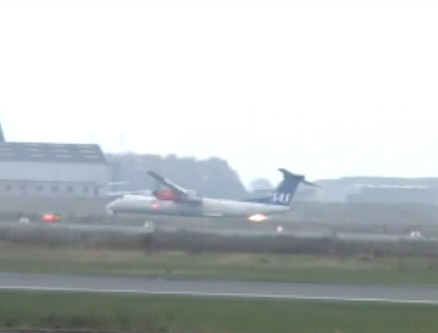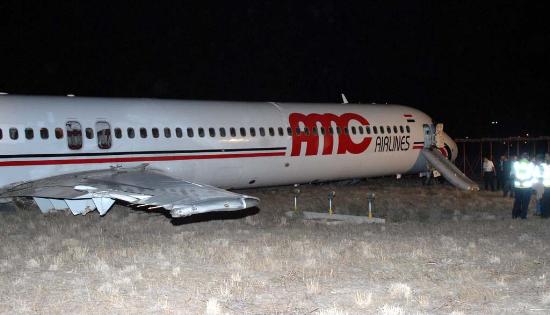The final NTSC investigation report of Garuda Indonesia flight GA200 has been released. The Boeing 737-497 (PK-GZC) crashed on 07 March 2007 during landing at Yogyakarta (Indonesia), killing 20 passengers and 1 flight attendant.
The report holds the pilot and copilot responsible for this accident and blames the Yogyakarta Airport rescue and fire fighting services for the lack of proper equipment, delays and an ineffective emergency plan.
The pilot is accused for doing an unstabilized approach, with too high altitude resulting in a steep flight path angle, at too high airspeed, ignoring several GPWS warnings and warnings made by the copilot and not doing a go-around.
The copilot is accused for not following company procedures and not taking control of the aircraft from the pilot when he noticed that the pilot in command repeatedly ignored all alerts and warnings.
Following the most important, related quotes from the final investigation report. For the full report please visit the link below.
The PIC intended to make an instrument landing system (ILS) approach to runway 09 at Yogyakarta
and briefed the copilot accordingly. Yogya Approach cleared the aircraft for a visual approach, with a
requirement to proceed to long final and report runway in sight. Although the crew acknowledged the
visual approach clearance, they continued with the ILS approach, but did not inform the controller. The
descent and approach were conducted in visual meteorological conditions.
At 23:55:33, when the aircraft was 10.1 miles from the runway, it was 1,427 feet above the initial fix of
2,500 feet published in the approach chart, and the airspeed was 283 knots. The pilot in command
descended the aircraft steeply in an attempt to reach the runway, but in doing so, the airspeed increased
excessively. As the aircraft was being flown at speeds that were in excess of the wing flaps operation
speed, the copilot elected not to extend the flaps as instructed by the PIC. During the approach, the
Ground Proximity Warning System (GPWS) alerts and warnings sounded 15 times and the copilot
called for the PIC to go around.
The PIC continued the approach with flaps 5 degrees, and the aircraft attained the glideslope near the
runway 09 threshold. Flaps 5 degrees is not a landing flap setting. The aircraft crossed the threshold, 89 feet above the runway, at an airspeed of 232 knots, 98 knots faster than the required landing speed for
flaps 40 degrees. The wind was north easterly at 9 knots. The groundspeed was 235 knots. The aircraft
touched down at an airspeed of 221 knots, 87 knots faster than landing speed for 40 degrees flap.
Shortly after touching down, the copilot called, with high intonation, for the PIC to go around.
The aircraft overran the departure end of runway 09, to the right of the centerline at 110 knots. The
aircraft crossed a road, and impacted an embankment before stopping in a rice paddy field 252 meters
from the threshold of runway 27 (departure end of runway 09). The aircraft was fired by the impact
forces and an intense, fuel-fed, post-impact fire. There were 119 survivors. One flight attendant and 20
passengers were fatally injured. One flight attendant and 11 passengers were seriously injured.
The aircraft was flown at an excessive airspeed and steep flight path angle during the approach and
landing, resulting in an unstabilized approach. The PIC did not follow company procedures that
required him to fly a stabilized approach, and he did not abort the landing and go around when the
approach was not stabilized. His attention was fixated or channelized on landing the aircraft on the
runway and he either did not hear, or disregarded the GPWS alerts and warnings and calls from the
copilot to go around.
The copilot did not follow company procedures and take control of the aircraft from the PIC when he
saw that the pilot in command repeatedly ignored the GPWS alerts and warnings. The Garuda
Simulator Pilot – Proficiency Check records showed no evidence of training or proficiency checks in
the vital actions and responses to be taken in the event of GPWS or EGPWS alerts and warnings, such
as ‘TOO LOW TERRAIN’ and ‘WHOOP, WHOOP, PULL UP’.
The Garuda Basic Operation Manual instructed a copilot to take control of the aircraft from the PIC,
and execute a go around, when an unsafe condition exists.
The Directorate General of Civil Aviation’s flying operations surveillance of Garuda was not effective
in identifying these and other safety deficiencies.
The Yogyakarta Airport’s rescue and fire fighting services vehicles were unable to reach the accident
site and some did not have appropriate fire suppressant. The delay in extinguishing the fire, and the
lack of appropriate fire suppressant agents, may have significantly reduced survivability. The airport
emergency plan and its implementation were less than effective.
(…)
On 2 April 2007, Garuda issued a notice to its pilots reinforcing its mandatory policy relating to a pilot
monitoring to take control of an aircraft and execute a go around in instances of unstabilized approach,
when the pilot flying does not make an appropriate response. The notice assures pilots that the
company will not take disciplinary measures for a go around executed under any unsafe or unstabilized
approach.
Link: Final investigation report




